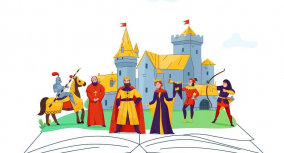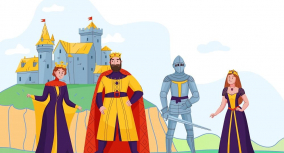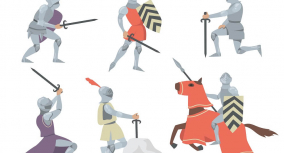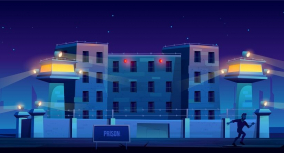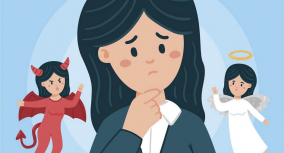In Sir Gawain and the Green Knight, symbolism plays an integral role. It underscores the poem’s themes of honor, morality, and human nature, mirroring Gawain’s demanding journey in many ways. There are numerous symbols in Sir Gawain and the Green Knight, but the most important and thoroughly studied are Sir Gawain’s shield with the pentangle, the axe, Bertilak’s castle, and the color green.
From this article by Custom-Writing.org experts, you’ll learn:
- What Sir Gawain’s shield symbolizes
- What the pentangle represents in Sir Gawain and the Green Knight
- How color symbolism reflects the poem’s key themes
Symbols in Sir Gawain and the Green Knight
The medieval poem Sir Gawain and the Green Knight is rich in symbolism and allegory. These stylistic devices add layers to the narrative and allow various interpretations.
Here are the main symbols the author uses:
- The shield in the poem incorporates several symbols that reinforce its meaning as an emblem of protection.
- The pentangle on the shield represents the principal Christian and chivalric virtues.
- Green in the poem symbolizes nature and the supernatural.
- Red represents courage and temptation.
- Gold emphasizes Sir Gawain’s nobility and purity.
Keep reading to learn more about them!

Sir Gawain’s Shield Symbolism
Sir Gawain’s shield is one of the central symbols in the poem. It is the last item of armor the protagonist receives.
The shield includes two powerful emblems:
- The image of Virgin Mary.
- A pentangle.
These emblems make it not just a piece of armor but also an amulet and a symbol of protection.
The Virgin Mary is painted from the inside of the shield, since her image should reinforce the courage and virtue of Sir Gawain. This painting also represents the purity and Christian devotion of the protagonist and establishes him as a knight of the Blessed Virgin.
The outside of the shield is red, with a golden pentangle depicted on it. Red and gold become Sir Gawain’s colors throughout the poem, in contrast to the green of the Green Knight. We’ll discuss these colors in more detail further in the article.
Now, let’s dive deeper into the symbolism of the pentangle.
What Is a Pentangle in Sir Gawain?
The poet uses 50 lines to describe the pentangle Sir Gawain adopted for his shield. According to the Gawain poet, the five-pointed star was initially designed by King Solomon. In the poem, two words refer to this symbol – “the pentangle” and the “endless knot.”
The symbol can be interpreted in several ways. On the main level, it signifies truth. However, truth in this poem is more than just honesty. It also means Christian faith, purity, and moral goodness.
This symbol also has additional meanings:
- The five wounds of Christ and the five joys of Mary.
- The five essential qualities that any knight should possess: Franchise, Fellowship, Cleanness, Courtesy, and Charity.
At the beginning of the poem, Gawain himself becomes a symbol of unwavering faith and honesty. Until he accepts the challenge, Gawain’s life represents all the virtues that the pentangle stands for.
Throughout the narrative, Gawain faces several tests. Not only his personal qualities but also his adherence to chivalric values is tested. Gawain fails to adhere to the standards he chose for himself, and the values he stands for fail. He prefers to win by cheating rather than keeping up with what the pentangle represents.
Quotes about Pentangle
Then they brought him his blazon that was of brilliant gules with the pentangle depicted in pure hue of gold. By the baldric he caught it and about his neck cast it: right well and worthily it went with the knight. And why the pentangle is proper to that prince so noble I intend now to tell you, though it may tarry my story.
Part I, Stanza 27
And well may he wear it on his worthy arms, For ever faithful five-fold in five-fold fashion Was Gawain in good works, as gold unalloyed, Devoid of all villainy, with virtues adorned in sight.
Part II, Stanza 35
First faultless was he found in his five senses, and next in the five fingers he failed at no time, and firmly on the Five Wounds all his faith was set that Christ received on the cross, as the Creed tells us; and wherever the brave man into battle was come, on this beyond all things was his earnest thought: that ever from the Five Joys all his valor he gained that to Heaven’s courteous Queen once came from her Child. For which cause the knight had in comely wise on the inner side of his shield her image depainted.
Part I, Stanza 28
It is a sign that Solomon once set on a time to betoken Troth, as it is entitled to do; for it is a figure that in it five points holdeth, and each line overlaps and is linked with another, and every way it is endless; and the English, I hear, everywhere name it the Endless Knot.
Part II, Stanza 27
Green Symbolism in Sir Gawain and the Green Knight
Colors are significant for the understanding of any literary piece. When it comes to Sir Gawain and The Green Knight, they become markers, navigating the entire plot.
The poem’s antagonist, the Green Knight, is described as a man in completely green armor. He is stronger, taller than a human, and can survive the beheading game. The audience connects these superb qualities with the unusual complexion. But he also has green garments, a green horse, green ax. Besides, he tells Gawain to meet him at the Green Chapel a year later. This exaggeration in using green color throughout the poem plays a vital role for the audience. It brings alive a lot of associations and mental connections.
In Medieval tradition, the color green is closely connected with several themes. The first one involves supernatural power and magic. The second theme this symbol stands for is nature and wilderness. It opposes King Arthur’s court that represents civility and life arranged around the knightly code. The third symbol is love and lust. The last one refers to youth, regeneration, and renewal.
The Green Knight and his alter ego Lord Bertilak represent both the supernatural and natural:
- They live in a castle far removed from civilization amid a green forest.
- They possess magic items, such as the green girdle.
- They are very close to nature.
The characters demonstrate these themes through seduction games and hunting scenes. Their lives are filled with green symbols. Just like the color green itself, The Green Knight has a lot of faces in the poem. Despite being harsh and strong, he is also merciful and knows how to forgive.
The most peculiar episode in the entire poem and the ultimate climax is depicted at the Green Chapel. Gawain wears the green girdle to go to the Green Chapel and meet the Green Knight. In this scene, supernatural, natural, and religious elements are closely interconnected. As it was mentioned, girdles are used in connection with magic and mythology in literature. In the Bible, the item refers to preparedness. Yet for Gawain, the green girdle becomes a symbol of his own. It is a reminder of his failure and a symbol of his moral rebirth. Like the girdle that goes through a transformation of its own, Gawain initially and at the end of the poem are two different characters.
Quotes about Color Green
All of green were they made, both garments and man: a coat tight and close that clung to his sides; a rich robe above it all arrayed within with fur finely trimmed, showing fair fringes of handsome ermine gay, as his hood was also…
Part I, Stanza 8
Very gay was this great man guised all in green, and the hair of his head with his horse’s accorded: fair flapping locks enfolding his shoulders, a big beard like a bush over his breast hanging that with the handsome hair from his head falling was sharp shorn to an edge just short of his elbows, so that half his arms under it were hid, as it were in a king’s capadoce that encloses his neck.
Part I, Stanza 9
I shall give you my girdle, less gain will that be.’ She unbound a belt swiftly that embracing her sides was clasped above her kirtle under her comely mantle. Fashioned it was of green silk, and with gold finished, though only braided round about, embroidered by hand; and this she would give to Gawain, and gladly besought him.
Part III, Stanza 73
All goes as he chooses at the Green Chapel; no one passes by that place so proud in his arms that he hews not to death by dint of his hand. For he is a man monstrous, and mercy he knows not; for be it a churl or a chaplain that by the Chapel rideth, a monk or a mass-priest or any man besides, he would as soon have him slain as himself go alive.
Part IV, Stanza 84
Other Colors in Sir Gawain and the Green Knight
In addition to green, other colors in Sir Gawain and the Green Knight also have a deep symbolic meaning. For instance, red and gold represent specific character traits and values. Let’s take a closer look at them.
Red Symbolism in Sir Gawain and the Green Knight
Red is a complex symbol with multiple meanings. This color is often associated with life and ardor. In the poem, it represents the passionate spirit of Sir Gawain – the spirit that induced him to accept the strange game proposed by the Green Knight to defend the honor of his sovereign.
Red also symbolizes courage. At the very beginning, we see Sir Gawain as the embodiment of this moral trait because he is ready to confront his fears and accept his destiny. That’s why the color red appears more than once in the description of Sir Gawain’s armor, which he receives standing on the luxurious red carpet.
First a carpet of red silk was arrayed on the floor,
Part II, Stanza 25
and the gilded gear in plenty there glittered upon it.
All was arrayed in red with rich gold studded,
Part II, Stanza 26
so that it glittered and glinted as a gleam of the sun.
Therefore on his shining shield was shaped now this knot,
Part II, Stanza 28
royally with red gules upon red gold set:
this is the pure pentangle as people of learning
have taught.
Red is also often associated with blood and violence. The author states that the Green Knight looks about the room with red eyes after he dares King Arthur’s court to accept his challenge. This episode emphasizes the atmosphere of danger and gives a start to the central problem of the poem.
The man on his mount moved in his saddle,
Part I, Stanza 14
and rudely his red eyes he rolled then about,
bent his bristling brows all brilliantly green,
and swept round his beard to see who would rise.
Another meaning of red color is love, temptation, and moral struggle. No wonder that it emerges in the description of the beautiful lady Bertilak, who tries to seduce Sir Gawain.
With chin and cheeks so sweet
Part III, Stanza 48
of blended red and white,
with grace then him did greet
small lips with laughter bright.
As you can see, the color red is a prominent symbolic motif throughout the story. It reflects different traits of the protagonist’s character and the specifics of his heroic quest.
Gold Symbolism in Sir Gawain and The Green Knight
Gold is considered a symbol of purity, nobleness, and prosperity. In the poem, it also represents the excellence of character.
At the beginning of Sir Gawain and the Green Knight, the protagonist is presented as a perfect knight with a heart of gold that adheres to the chivalric code and Christian virtues.
Gawain as good was acknowledged and as gold refinéd,
Part II, Stanza 27
devoid of every vice and with virtues adorned.
The armor embellished with gold that the hero receives before going to confront the Green Knight also reinforces the symbolism:
When he was hasped in his armor his harness was splendid:
Part II, Stanza 26
the least latchet or loop was all lit with gold.
The holy pentangle depicted on Sir Gawain’s shield is also gold. The color of this symbol underlines the knight’s faithfulness to the divine principles.
Then they brought him his blazon that was of brilliant gules
Part II, Stanza 27
with the pentangle depicted in pure hue of gold.
The author compares the young knight to gold, emphasizing his nobility and purity. And although he isn’t able to withstand the natural urge to save his life, Sir Gawain still can acknowledge it and learn his lesson.
